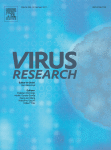Ver ítem
- xmlui.general.dspace_homeCentros e Institutos de InvestigaciónCICVyA. Centro de Investigación en Ciencias Veterinarias y AgronómicasInstituto de BiotecnologíaArtículos científicosxmlui.ArtifactBrowser.ItemViewer.trail
- Inicio
- Centros e Institutos de Investigación
- CICVyA. Centro de Investigación en Ciencias Veterinarias y Agronómicas
- Instituto de Biotecnología
- Artículos científicos
- Ver ítem
Interaction of Mal de Río Cuarto virus (Fijivirus genus) proteins and identification of putative factors determining viroplasm formation and decay
Resumen
Mal de Río Cuarto virus (MRCV) is a member of the Fijivirus genus, within the Reoviridae family, that repli-cates and assembles in cytoplasmic inclusion bodies called viroplasms. In this study, we investigatedinteractions between ten MRCV proteins by yeast two-hybrid (Y2H) assays and identified interactionsof non-structural proteins P6/P6, P9-2/P9-2 and P6/P9-1. P9-1 and P6 are the major and minor compo-nents of the viroplasms respectively, whereas P9-2
[ver mas...]
Mal de Río Cuarto virus (MRCV) is a member of the Fijivirus genus, within the Reoviridae family, that repli-cates and assembles in cytoplasmic inclusion bodies called viroplasms. In this study, we investigatedinteractions between ten MRCV proteins by yeast two-hybrid (Y2H) assays and identified interactionsof non-structural proteins P6/P6, P9-2/P9-2 and P6/P9-1. P9-1 and P6 are the major and minor compo-nents of the viroplasms respectively, whereas P9-2 is an N-glycosylated membrane protein of unknownfunction. Interactions involving P6 and P9-1 were confirmed by bimolecular fluorescence complementa-tion (BiFC) in rice protoplasts. We demonstrated that a region including a predicted coiled-coil domainwithin the C-terminal moiety of P6 was necessary for P6/P6 and P6/P9-1 interactions. In turn, a shortC-terminal arm was necessary for the previously reported P9-1 self-interaction. Transient expression ofthese proteins by agroinfiltration of Nicotiana benthamiana leaves showed very low accumulation levelsand further in silico analyses allowed us to identify conserved PEST degradation sequences [rich in pro-line (P), glutamic acid (E), serine (S), and threonine (T)] within P6 and P9-1. The removal of these PESTsequences resulted in a significant increase of the accumulation of both proteins.
[Cerrar]

Fuente
Virus research 230 :19-28. (2017)
Fecha
2017
ISSN
0168-1702
Formato
pdf
Tipo de documento
artículo
Palabras Claves
Derechos de acceso
Restringido
 Excepto donde se diga explicitamente, este item se publica bajo la siguiente descripción: Creative Commons Attribution-NonCommercial-ShareAlike 2.5 Unported (CC BY-NC-SA 2.5)
Excepto donde se diga explicitamente, este item se publica bajo la siguiente descripción: Creative Commons Attribution-NonCommercial-ShareAlike 2.5 Unported (CC BY-NC-SA 2.5)

